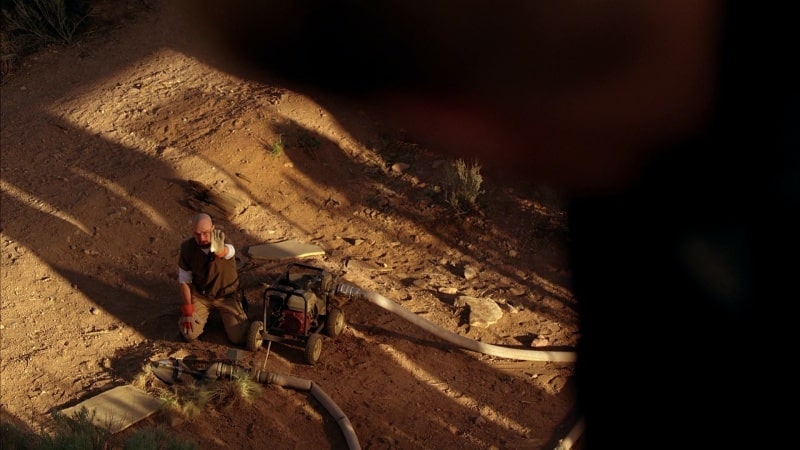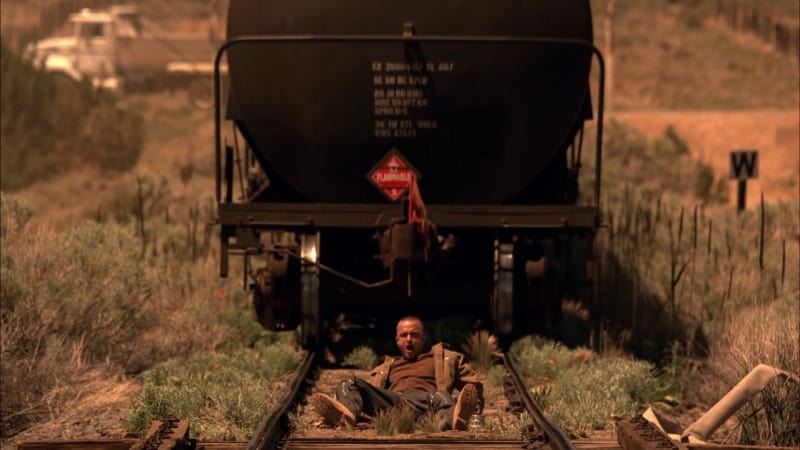This essay is part of our series Episodes, a bi-weekly column in which senior contributor Valerie Ettenhofer digs into the singular chapters of television that make the medium great.
When we think of Breaking Bad with a half-decade of retrospect, certain moments are more likely to be seared on our brains than others. Jesse, crying with a gun in his shaking hand. Walt, letting out a deranged laugh while laying flat on his back in a dusty pile of money. Jane, asphyxiating to death in bed next to the man she loves. Hank facing down the Salamanca cousins in a parking lot.
For all of Breaking Bad’s skilled, award-winning characterization, Vince Gilligan’s crime series is also capable of–and indeed, perhaps best at–delivering brutal shocks and almost unbearably intense thrills. In 2008, when Breaking Bad premiered, “criminals barely getting away with it” was basically a genre in itself. Other networks were airing series like Dexter, Weeds, and Sons of Anarchy, all of which frequently mined dangerous run-ins with criminals and cops alike for narrative tension. These shows were no Breaking Bad. Gilligan and his team revitalized and mastered the by then already-familiar close call trope, injecting scenes with nail-biting levels of suspense and arranging them around clever and complex circumstances that often drew several major characters into a single climactic event. Then, in its final season, Breaking Bad topped itself once more to give us one last close call for the ages: “Dead Freight.”
“Dead Freight” is a clear standout in the pantheon of great Breaking Bad episodes–only four rate higher on IMDb: the fourth and fifth season finales, and the one-two punch of “To’hajiilee” and “Ozymandias.” Sandwiched between Skylar’s (Anna Gunn) suicidal confrontation with Walt (Bryan Cranston) and Mike Ehrmantraut’s (Jonathan Banks) final fade-out, the Emmy-nominated episode serves as one of the series’ last near-standalone missions. It also captures the Western spirit more directly than nearly any other outing, brings back Jesse’s (Aaron Paul) Achilles heel in a truly shocking way, and introduces an at first seemingly innocuous character–Jesse Plemons’ Todd–who ends up being a major player in the series’ endgame.
But who are we kidding? You’re here to read about the heist.

Now eight years in the rearview, Walt, Jesse, Mike, and Lydia’s (Laura Fraser) plan to steal hundreds of gallons of pricey and precious methylamine from a train without detection seems like the stuff of legends; in the red dust of the New Mexico desert, they’re like a group of Western bandits whose outlaw exploits would’ve inspired folk songs in a different era. It’s easy, then, to misremember the heist itself as taking up the majority of the episode, when in reality it spans only the last 14 minutes. The planning stages give us the best lines of the episode–“Everyone sounds like Meryl Streep with a gun to her head,” Mike quips when Lydia pleads for her life–but the final sequence is pure, bracing adrenaline.
The specifics of the heist, which involve a broken-down truck with a stalling driver blocking the train tracks and two hose-connected tanks buried in the desert, are less important than the pure, unparalleled thrill the third act brings viewers. This is the only episode that credits series writer and story editor George Mastras as its director–in fact, it’s the only directorial credit to Mastras’ name, ever–but it’s a distinct feat of technical mastery. The train sequence was clearly a complex shoot that involved several moving parts, and the resulting footage makes use of multiple camera angles, quick cuts, and lighting that captures the arid yet visually saturated landscape of New Mexico. The soundtrack, by Dave Porter, is mechanical and persistent, the perfect musical equivalent to a ticking time bomb by way of a clanging locomotive.
Altogether, the heist is a teeth-clenching, heart-pumping, almost maddeningly excellent kind of small-screen magic. The first time I saw the episode, I took several laps around my house afterward, overwhelmed with some kind of wild, kinetic energy as if I myself was laying under train tracks as an engine roared above me. But, of course, there’s always a comedown, and in this case, it’s the last minute of the episode.

I’ve written before about how Jesse is the heart of Breaking Bad, and how his own heart, more often than not, has a direct link to the children of the series who are caught in the crossfire of the drug business. “Dead Freight” drives this point home like a nail through the back of a hand. The last moment of the episode is painful, piercing, and both inevitable and wholly unexpected. In the cold open, which by hour’s end is the last thing on viewers’ minds, a boy in the desert pulls a glass jar from his jacket and catches a tarantula. He smiles through his braces as it crawls on him, somehow looking like both a predator and a pet. In the middle of the episode, Jesse tells Todd that no one can know about the heist, a naive statement made after coming up with a plan with the express purpose of avoiding loss of life. At the end of the episode, the boy stumbles upon the freshly-minted outlaw legends as they’re congratulating one another, and Todd promptly shoots him in the chest.
The business of mythmaking is a much bloodier one than those folk songs might have you believe. Sure, Breaking Bad gives Walt a cool black hat and a cool nickname and a cool train heist, but it also shows us what it looks like to systematically strip away your own humanity, to see brutality and death and, eventually, to pull the trigger yourself. “Like Jesse James?” Jesse asks when the heist idea is first brought up, clearly as exhilarated as we are. The gunshot at hour’s end, the aftermath of which ushers the series ever-closer to its dark, memorable ending, is the answer to his question. If they’re imagining themselves as outlaws, then this picture-perfect heist, cut short by a senseless casualty, is Jesse and Walt’s last hurrah.
0 comments:
Post a Comment